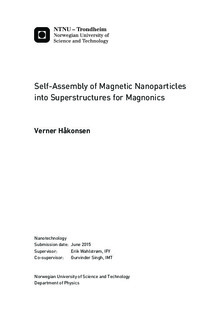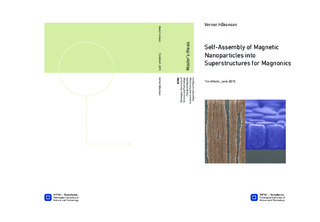| dc.description.abstract | Magnonics is a young and evolving field with the potential to replace conventional electronics. This field relies on the use of spin waves, or magnons, rather than electrons as the information carrier in logic devices, which brings along advantageous features when it comes to device performance. However, to accurately control and manipulate magnons, periodically patterned magnetic materials are needed, conventionally obtained by top-down methods such as the deposition of a magnetic thin film followed by critical patterning steps, which are both time consuming and expensive.
The bottom-up method of liquid-air interface self-assembly in a magnetic field was employed as a simplified method to successfully fabricate ordered one-dimensional magnonic structures, consisting of 12 nm magnetite nanocubes. This method offers great flexibility in terms of the direction and strength of an applied magnetic field, as well as the size, morphology and concentration of the nanoparticles involved. In addition, Markov Chain Monte Carlo simulations utilizing the Metropolis-Hastings algorithm, was performed to simulate and gain insight to the self-assembly mechanism.
Two types of one-dimensional structures were considered, namely horizontal lines and vertically aligned rods. Volumetric solvent amount studies at fixed uniform magnetic fields, a uniform field study at fixed volume and an oleic acid surfactant concentration study was performed in the context of line-formation. Optimal magnetic field strength and total dispersion volume were established for narrow separated monolayered lines. Lines also seem to adapt a nanocube configuration corresponding to the [100]-direction parallel to the applied magnetic field for values below 750 G, and a [110]-configuration for values above 750 G, in excellent agreement with simulation results. Vertical gradient magnetic fields were investigated, resulting in superstructured rods. Experimentally, studies performed with varying magnetic field strengths and gradients, as well as concentration of nanocubes and dispersion volume, revealed that the level of one-dimensionality in terms of aspect ratio tend to increase with increasing magnetic fields, but did not seem to show any clear correlation to the value of the gradient. In addition, increasing both concentration and volume resulted in an increase of aspect ratio.
A proposed magnetic field-induced self-assembly mechanism was established, in which a combination of translational and rotational Brownian motion, magnetic dipole-dipole interactions, magnetocrystalline anisotropy, as well as increasingly stronger van der Waals attractions with increasing oleic acid concentration upon evaporation, served to explain obtained ordered superstructures. Experiments supported by simulations demonstrate that the final stage of the process in pure oleic acid, is imperative for long range ordering, in which the final obtained structure is a compromise between van der Waals interactions and magnetic dipole-dipole interactions.
Ferromagnetic resonance (FMR) was utilized to magnetically characterize obtained magnonic structures. Second peaks presumably corresponding to low $k$ magnonic modes were observed for all samples considered, most probably with the applied field in the lengthwise direction in case of the one-dimensional structures. Shape anisotropy was well expressed in case of the one-dimensional structures. | |

